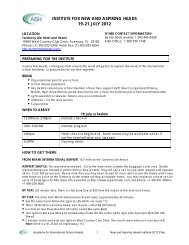AISHnet Survey - Academy for International School Heads
AISHnet Survey - Academy for International School Heads
AISHnet Survey - Academy for International School Heads
Create successful ePaper yourself
Turn your PDF publications into a flip-book with our unique Google optimized e-Paper software.
Can a Lecture Be Experiential?<br />
While in graduate school, I had an interesting conversation with Dr. Jasper Hunt my<br />
professor at Minnesota State University, Mankato. We were filling out conference proposal<br />
<strong>for</strong>ms <strong>for</strong> an experiential education conference. He commented about the "check box" on<br />
the application <strong>for</strong>m requesting us to identify which portion of the presentation would be<br />
experiential and which portion would be lecture based. Jasper shared that he felt this was<br />
counter productive to defining a quality presentation. He argued that a good lecture CAN<br />
be experiential.<br />
I have reflected many times on that comment when attending (or delivering) a lecture or<br />
lesson. Recently this topic came up in my work with both classroom teachers and<br />
corporate trainers who struggle with the need to cover a great deal of curricular content in<br />
a short time while in a structured classroom or boardroom setting. These educators<br />
struggle to balance their need to cover the content and their desire to teach more<br />
experientially in order to engage learners and create lasting lessons.<br />
This past summer I attended two different keynote lectures at educational conferences<br />
that were very engaging and created lasting impressions with me. I reflected on that<br />
conversation with Jasper and wondered: What was it that made those lectures engaging?<br />
Would they be considered “experiential”?<br />
When I compared the presenters’ actions with the principles of experiential education, I<br />
found the educators did incorporate many tenets of experiential education and brainfriendly<br />
teaching strategies. And they did so in what might not usually be considered an<br />
experiential <strong>for</strong>mat <strong>for</strong> teaching: a giant lecture hall and a power point presentation.<br />
Here is what I noticed:<br />
Emotional Engagement:<br />
When the speaker is knowledgeable and passionate about their subject it comes through<br />
regardless of the <strong>for</strong>mat of their lesson. This kind of energy is contagious and can’t help<br />
but initiate some sense of relevancy and buy in from audience members. When Dr. Hunt<br />
lectured on the subject of experiential education philosophy or ethics, his interest and<br />
passion around the subject were obvious and infectious. I remember being drawn in by his<br />
enthusiasm and class time flying by.<br />
Recently I worked with a group of high school teachers who are trying to teach more<br />
experientially in an atmosphere with a strong emphasis on test scores. I challenged them<br />
to reflect on what it was that first ignited their passion around the subject area. If they<br />
are in touch with that passion and find a way to communicate it, they will find a<br />
way to stimulate some of that same passion in their students.<br />
Relevancy and transference to real life:<br />
The speakers infused personal stories that the audience could relate to, both about<br />
themselves and others. They also asked audience members to reflect on a related personal<br />
experience of their own.



